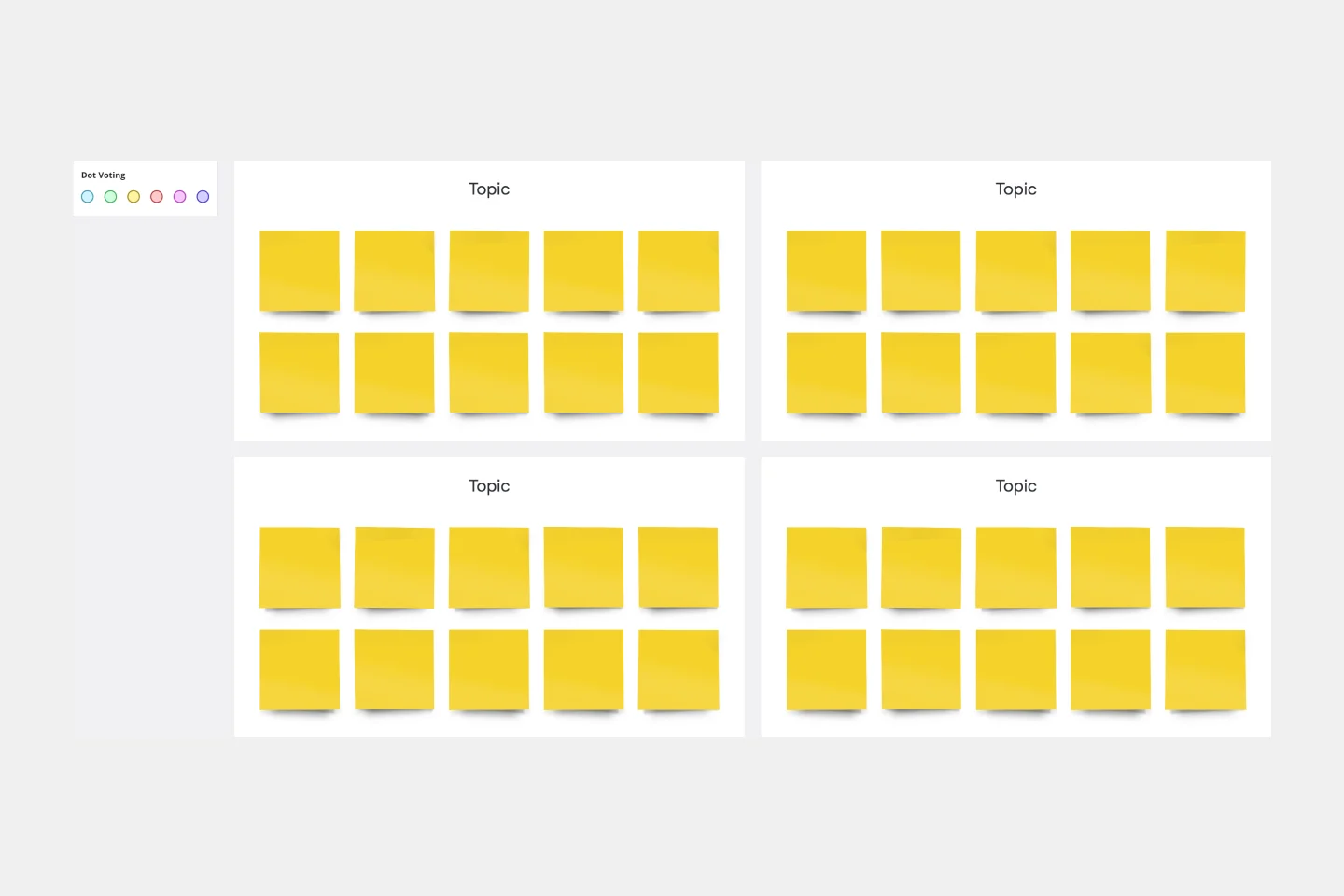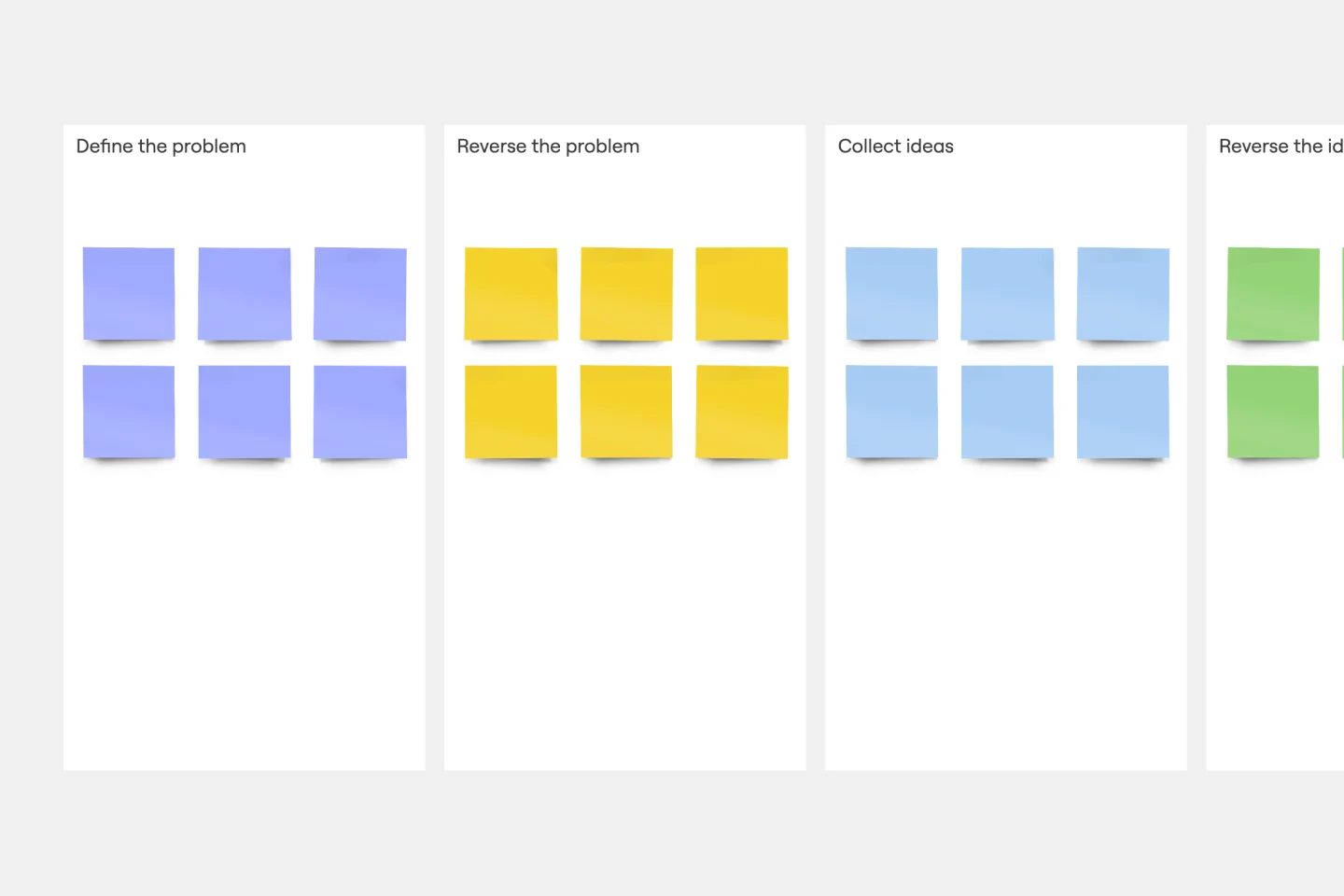About the Lotus Diagram Template
The lotus diagram template is a creative-thinking technique, also known as the "lotus blossom technique.” Proposed by Michael Michalko, it helps you expand your thinking beyond your usual paths. The lotus blossom technique focuses the power of brainstorming on areas of interest by using a visual representation of an idea. It's similar to mind mapping (but more structured) and pushes you in ways you don’t find in classic mind mapping.
What is a lotus diagram?
A lotus diagram is an organization and online brainstorming tool. It helps define key concepts or parts of a broader picture. The center of the diagram represents the main idea, with eight surrounding boxes representing additional concepts.
Brainstorming can be a frustrating experience. Sometimes, your team comes in with a thousand ideas they’re ready to share. Other times, the well runs dry. A lotus diagram can empower you to run smoother, more effective brainstorming sessions. Use this lotus diagram template to visualize themes and explore alternative paths.
How to use a lotus diagram template
Start with a central idea or theme, and then expand outwards with solution areas or related themes in an iterative manner. The technique encourages you to have a fully fleshed-out idea space before considering the idea completed.
Benefits of a lotus diagram template
Many teams benefit from using a lotus diagram template, mainly because it gives a twist to a regular brainstorming session. Here are a few advantages of using the lotus diagram:
1. Have better brainstorming sessions
Lotus diagrams encourage lateral thinking. If people get stuck, you can return to the diagram to generate ideas that might be tangentially related to your main topic.
2. Promote logical thinking
In using a lotus diagram, you’re constantly filing topics according to their relationship to the main topic. That makes it a helpful tool for keeping your meetings focused and on task.
3. Foster creativity
A lotus diagram encourages you to ask critical, incisive questions about the main topic, generating new ideas for discussion.
4. Break down complex ideas
Lotus diagrams can be useful for discussing complex topics with many moving parts. By uncovering related ideas, you can better understand the main idea at the center of the diagram.
Getting started with Miro's lotus diagram template
When you use Miro to create the lotus diagram, you can:
Have endless space for your collaboration. Brainstorm ideas with your distributed teammates as if you were all in one room, and engage everyone in one visual workspace to ideate and discuss all topics together.
Customize and fill out the lotus diagram template as you go along. Change colors and add sticky notes and arrows to experiment with different ideas.
Upload documents and images to make your collaboration and ideation session more visual and vivid.
Save your completed lotus diagram in .JPEG or .PDF to always have it ready to view.
Lotus Diagram Template FAQs
What is the purpose of a lotus diagram?
A lotus diagram is a brainstorming and organization tool. It is an effective thinking tool that helps you logically organize information to solve complex problems and manage tasks.
When should lotus diagrams be used?
A lotus diagram can be used in various ways within an organization. It is best used in a brainstorming process to help break down broad topics into smaller components to offer easy analysis and prioritization within a task.

Miro
Your virtual workspace for innovation
Miro is an innovation workspace designed for teams of every size, everywhere, to dream, design, and build the future together. Our mission? To empower these teams to create the next big thing, powered by AI at every step of the way. Over 90 million users around the world rely on Miro to untangle complex ideas, put customer needs first, and deliver products and services faster. All supported by best-in-class security, compliance, and scalability.
Categories
Similar templates
Research Topic Brainstorm Template

Research Topic Brainstorm Template
Coming up with a topic for a research project can be a daunting task. Use the Research Topic Brainstorm template to take a general idea and transform it into something concrete. With the Research Topic Brainstorm template, you can compile a list of general ideas that interest you and then break them into component parts. You can then turn those parts into questions that might be the focus for a research project.
Cluster Diagram Template

Cluster Diagram Template
The Cluster Diagram Template is a valuable tool for organizing and connecting ideas, concepts, and information in a visually compelling and coherent manner. The template's design centers on grouping related ideas around a core concept, creating a transparent and hierarchical structure. This clustering not only aids in breaking down complex information into manageable segments but also significantly enhances the process of idea generation and brainstorming. A structured yet flexible visual framework encourages deeper engagement and more precise understanding, making it an essential asset for teams and people looking to bring order to their creative and analytical processes.
Brainwriting Template

Brainwriting Template
Brainstorming is such a big part of ideation. But not everyone does their best work out loud and on the spot, yelling out thoughts and building on others’ ideas. Brainwriting is a brilliant solution for them—creative thinkers who happen to be more introverted. This approach and template invites participants to reflect quietly and write out their ideas, and then pass them to someone else who will read the idea and add to it. So you’ll get creative ideas from everyone—not just the loudest few.
Sticky Note Packs Template

Sticky Note Packs Template
Use Miro’s Stickies Packs template to facilitate your brainstorming and group sessions. Use them to organize your ideas, collaborate as a team, and encourage participation from everyone involved.
Reverse Brainstorming Template

Reverse Brainstorming Template
Reverse brainstorming is a technique that prompts a group to think of problems, rather than solutions. Because we naturally think of problems, it’s a great way to get a group to anticipate problems that may occur during a project. To engage in reverse brainstorming, start by identifying the problem, and then think of things that might exacerbate it. Ask your team to generate ideas around ways in which the problem could get worse. Reverse the problems into solutions again, and then evaluate your ideas.
Research Topic Brainstorm Template

Research Topic Brainstorm Template
Coming up with a topic for a research project can be a daunting task. Use the Research Topic Brainstorm template to take a general idea and transform it into something concrete. With the Research Topic Brainstorm template, you can compile a list of general ideas that interest you and then break them into component parts. You can then turn those parts into questions that might be the focus for a research project.
Cluster Diagram Template

Cluster Diagram Template
The Cluster Diagram Template is a valuable tool for organizing and connecting ideas, concepts, and information in a visually compelling and coherent manner. The template's design centers on grouping related ideas around a core concept, creating a transparent and hierarchical structure. This clustering not only aids in breaking down complex information into manageable segments but also significantly enhances the process of idea generation and brainstorming. A structured yet flexible visual framework encourages deeper engagement and more precise understanding, making it an essential asset for teams and people looking to bring order to their creative and analytical processes.
Brainwriting Template

Brainwriting Template
Brainstorming is such a big part of ideation. But not everyone does their best work out loud and on the spot, yelling out thoughts and building on others’ ideas. Brainwriting is a brilliant solution for them—creative thinkers who happen to be more introverted. This approach and template invites participants to reflect quietly and write out their ideas, and then pass them to someone else who will read the idea and add to it. So you’ll get creative ideas from everyone—not just the loudest few.
Sticky Note Packs Template

Sticky Note Packs Template
Use Miro’s Stickies Packs template to facilitate your brainstorming and group sessions. Use them to organize your ideas, collaborate as a team, and encourage participation from everyone involved.
Reverse Brainstorming Template

Reverse Brainstorming Template
Reverse brainstorming is a technique that prompts a group to think of problems, rather than solutions. Because we naturally think of problems, it’s a great way to get a group to anticipate problems that may occur during a project. To engage in reverse brainstorming, start by identifying the problem, and then think of things that might exacerbate it. Ask your team to generate ideas around ways in which the problem could get worse. Reverse the problems into solutions again, and then evaluate your ideas.